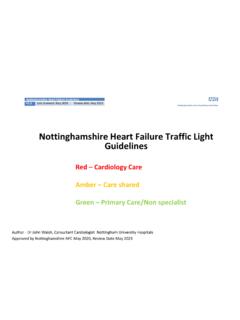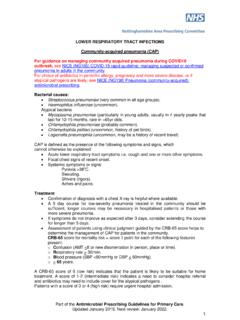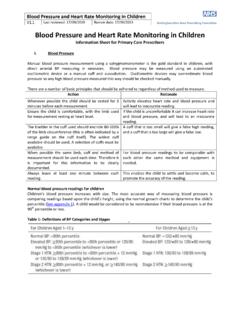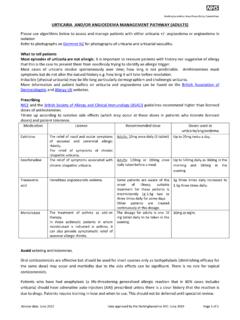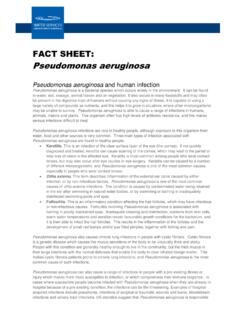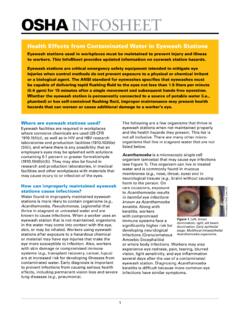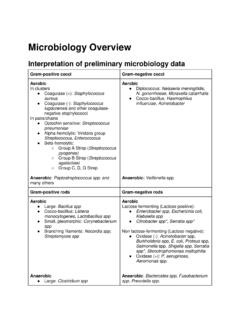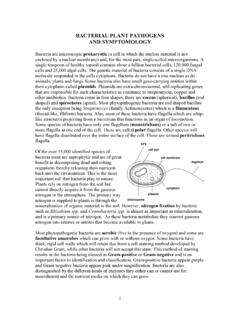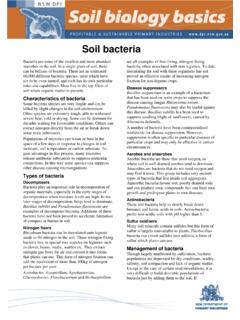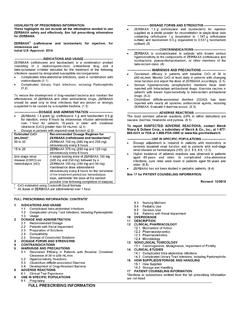Transcription of Supporting guideline for the prescribing of nebulised ...
1 Approved by the Nottinghamshire Area prescribing Committee March 2017, reviewed March 2020, next review March 2023 1 Supporting guideline for the prescribing of nebulised colistimethate (Colomycin ) in the treatment of pseudomonas aeruginosa lung infections in adult patients with non- Cystic Fibrosis Bronchiectasis Background pseudomonas aeruginosa is a pathogen that causes severe lung damage in patients who become colonised and then chronically infected. Patients with Non-Cystic Fibrosis (CF) Bronchiectasis are at risk of significant morbidity and mortality from the damage caused by this pathogen. nebulised antipseudomonal antibiotic treatment has been shown to improve lung function, slow the rate of respiratory decline and reduce the frequency of exacerbations of infection in these patients.
2 nebulised antibiotics are able to achieve high local concentrations with low systemic absorption and toxicity as opposed to intravenous antibiotics, where there is high risk of developing adverse effects from systemic absorption. Licensed indication Colistimethate (colistin) is only licensed for the treatment by inhalation of pseudomonas aeruginosa lung infections in patients with cystic fibrosis (CF). The use of inhaled colistimethate for the treatment of infection in patients with non-CF Bronchiectasis is an unlicensed indication but common practice and recommended in BTS guidance. Nottinghamshire APC status nebulised colistimethate is classified as Amber 2 (specialist initiation) in the Nottinghamshire Joint Formulary.
3 Place in therapy This will be tailored to individual patients by secondary care, but long-term treatment with nebulised colistimethate will be considered in the following circumstances in line with BTS guidance: Patients chronically colonised with P aeruginosa AND Patients having 3 exacerbations per year requiring antibiotic therapy or patients with fewer exacerbations that are causing significant morbidity. The aim of treatment can be to either control infection and limit further lung damage or attempt to eradicate. There is no clear evidence regarding the best way to eradicate pseudomonas and therefore a variety of regimens are used. For eradication, colistimethate is given for three months and ciprofloxacin 750mg twice daily can be co-administered (2).
4 Approved by the Nottinghamshire Area prescribing Committee March 2017, reviewed March 2020, next review March 2023 1 Review A review of the patient s condition and efficacy of treatment will initially be conducted at least every six months by secondary care. Once patients are stable, the frequency of review by secondary care may be reduced. A treatment benefit is likely to not be seen until after six months of treatment. If patients are showing no benefit after this time, they should be reviewed in clinic where stopping treatment will be considered. Responsibilities and Roles Secondary Care Clinician Responsibilities: 1. To diagnose pseudomonas aeruginosa infection in non - cystic fibrosis bronchiectasis patients based on a timely and comprehensive assessment.
5 2. To initiate colistin and ensure the first test dose is administered and patient is assessed before a continuous prescription is requested. 3. To supply the initial 28 days treatment. 4. To provide the nebuliser system and train the patient/carer in the use of the nebuliser and preparation of the medication. 5. To co-ordinate servicing/maintenance of the nebuliser system. 6. To monitor for response and adverse drug reactions (ADRs) during the first test dose and the initiation period. 7. To liaise with the general practitioner (GP) to share the patient s care when the test dose has been carried out and proven benefit has been established. 8. To outline to the GP when therapy may be stopped assuming no improvement is recognised in the patient s condition.
6 9. To review the patient s condition and efficacy of treatment three months after discharge from secondary care, and then as deemed necessary by the consultant, with consideration at each review as to whether treatment needs to continue. 10. To evaluate ADRs raised by the GP and evaluate any concerns arising from physical checks & reviews undertaken by the GP. 11. To advise the GP on related issues such as medication interactions etc. 12. To advise the GP on supply issues related to the prescribing of nebulised colistin. 13. In relation to eradication therapy, secondary care will supply the patient with sputum collection pots and advise the patient to send the specimens to their GP for processing in the laboratory.
7 14. The Consultant Physician will follow up results of the sputum cultures after the three months eradication therapy, and relay any information to the GP. 15. In relation to prophylactic therapy, advise the GP if the patient is on continuous treatment with colistin or on an alternative month on month off basis. 16. To advise the GP that the patient should be prescribed the Colomycin brand of colistin. GP Responsibilities: 1. To monitor the patient s overall health and wellbeing. 2. To observe the patient for evidence of ADRs or any abnormalities and raise with the secondary care clinician if necessary. Approved by the Nottinghamshire Area prescribing Committee March 2017, reviewed March 2020, next review March 2023 1 3.
8 To prescribe Colomycin after achievement of a stable dose regimen by secondary care. 4. To ensure advice is sought from the secondary care clinician if there is any significant change in the patient s physical health status. 5. To reduce and stop treatment in line with secondary care clinicians original request. 6. For eradication therapy, GP should facilitate sputum samples from the patient are sent for processing two weeks after patient has completed the three month eradication therapy, and send any further samples for processing if requested to. Patient s role: 1. Report any adverse effects to their GP or consultant whilst using Colomycin for nebulisation.
9 2. Take responsibility for their care and treatment and seek clarification if they have any questions regarding their condition/treatment. 3. Correctly store and administer the medicine. 4. Attend for follow-up appointments. Dosage and Administration a) Adult patients with non-CF bronchiectasis for maintenance treatment: - Colomycin 1or 2 million units nebulised twice daily. - Dose should be diluted in water for injection or sodium chloride to a volume between 2-4ml dependant on brand and nebuliser system employed. b) Adult patients for eradication of first pulmonary colonisation: - Colomycin 2 million units nebulised twice daily for three months. - Eradication is not always successful and should only be attempted once.
10 - Dose should be diluted in water for injection or sodium chloride to a volume between 2-4ml dependant on brand and nebuliser system employed. - Ciprofloxacin 750mg twice daily is co-administered for three months. Special warning/advice to patient Importance of adherence to the drug regime must be emphasised to patients as compliance to twice daily nebulisation of Colomycin can be an issue for patients and may result in reduced efficacy of the drug (3). Whilst on treatment, patients should continue with their standard treatments as clinically necessary. Where several different respiratory therapies are used, the following order is recommended: bronchodilator, sodium chloride 6% or 7% (hypertonic saline), chest physiotherapy, other inhaled medicines, and finally nebulised Colomycin.
